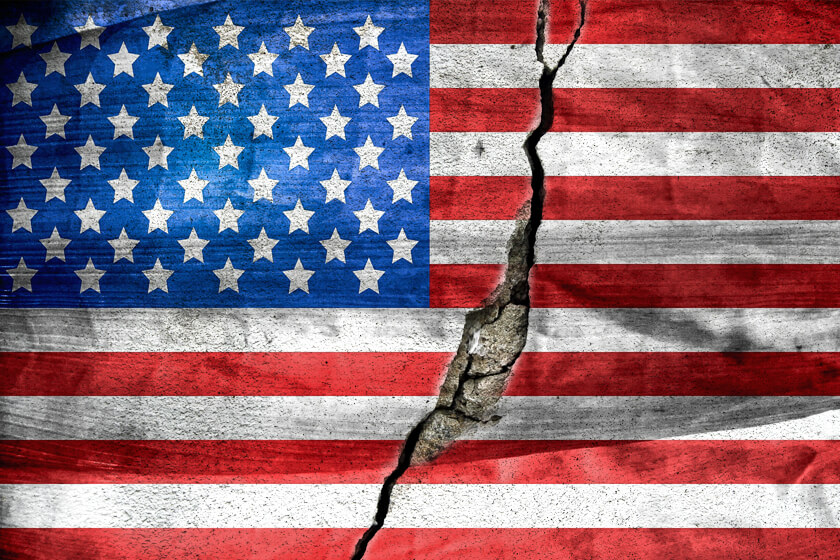West Long Branch, NJ – Three-in-four Americans say the country continues to be greatly divided with a majority saying the situation has worsened since Donald Trump took office. On the other hand, the Monmouth University Poll also found a slight dampening of the amount of anger directed toward Washington. Neither political party is seen as giving enough attention to key economic concerns, but the GOP has an ever-so-slight advantage among independent voters and its own partisans when it comes to paying the right amount of attention to both economic and social issues.
Fully three-quarters (75%) of the nation feel that Americans are greatly divided when it comes to our most important values. This number is up slightly from 70% who said the same last year, with widespread agreement across all demographic groups. Only 22% believe that Americans are united and in agreement about our core principles.
Just over half (52%) of the public say that the country has become more divided since Pres. Trump took office. Only 11% say the country has actually become more united and 34% say not much has changed since Trump entered the White House. Those who say the country has become more divided since Trump’s inauguration include 71% of Democrats, 50% of independents, and 35% of Republicans. Only 16% of Republicans think the country has become more united under Trump, which is not significantly different from the 10% of independents and 7% of Democrats who feel the same.
“The country is divided and it’s not getting better. The body politic pitted against itself may be the new normal,” said Patrick Murray, director of the independent Monmouth University Polling Institute in West Long Branch, New Jersey.
A majority (53%) of the public feel that all or most Americans feel angry about Washington politics. This result is down from 62% who said the same just over one year ago. Democrats (59%) and independents (56%) are more likely than Republicans (42%) to feel that the public is largely angry at Washington. This finding represents a 30 point drop in perceived anger among Republicans (from 72% in 2016), while the results for independents (61%) and Democrats (56%) are largely unchanged from 2016.
Most of the public (53%) sees partisans from both sides of the aisle as equally angry at the federal government, although 35% say these angry Americans tend more to be Democrats and 8% say they tend more to be Republicans. These results have shifted from a year ago, when 63% said Americans from both parties were equally angry, 25% said Republicans were more angry, and 8% said Democrats were more angry. Currently. 6-in-10 Democrats (59%) and independents (59%) say Americans from both parties are equally angry while half of Republicans (50%) say that Democrats are the ones carrying a grudge. A year ago, Americans who identified as Democrats (59%), Republicans (61%), and independents (66%) were just as likely to see this angry mood affecting voters from both parties equally.
“When party control of the executive and legislative branches was split, Americans of all partisan stripes tended to see both sides as angry. Now that the GOP runs both ends of Pennsylvania Avenue, Republicans are more likely to paint Democrats as the enraged group,” said Murray.
The Monmouth University Poll also asked Americans whether each party is paying the right amount of attention to everyday economic issues and hot button social issues. Both parties earn poor marks for how much energy they devote to dealing with the economic concerns facing Americans. Nearly two-thirds say that both the Republican Party (63%) and the Democratic Party (65%) do not give enough attention to these issues. Just 1-in-4 say the parties pay the right amount of attention (28% Republican and 25% Democrat) and very few say they pay too much attention to everyday economic issues (4% Republican and 5% Democrat).
When it comes to hot button social issues, nearly half (48%) of the public say the Republican Party does not give enough attention and nearly 4-in-10 (38%) say the Democratic Party does not. Only 17% feel that the GOP focuses too much on social issues while slightly more (28%) say the same about the Democrats. About 1-in-4 say both parties give social issues the right amount of attention (26% Republican and 25% Democrat).
There appears to be a slight advantage for Republicans on this issue-focus metric when the results of partisans and independents are examined. Slightly more Americans who identify as Republican (51%) feel their party gives economic issues the right amount of attention than Democratic identifiers say about their own party (44%). Independents do not have a positive view of either side when it comes to economic issues, but the Democratic Party (71% not enough attention) is seen as slightly worse than the Republican Party (62% not enough attention).
“These results should give pause to anyone already writing stories about the Republicans being in trouble for the midterms. There is a long way to go until 2018 and key voting blocs are not predisposed to simply write off the GOP and flock to the Democrats,” said Murray. He added, “This poll was conducted before the new health care and budget proposals were announced, so it will be interesting to see if these attitudes shift as the public digests how this will affect them.”
It is also worth noting that most Democratic-identifiers say the GOP does not pay enough attention to social issues (64%) while Republican-identifiers tend to say that the Democratic Party pays too much attention to these hot button issues (49%).
“These conflicting results may simply be a reflection of who is calling the shots in Washington. Conservatives may feel that their concerns are finally being heard and are less worried about having a seat at the table, while Democrats feel left out in the cold,” said Murray.
The Monmouth University Poll was conducted by telephone from March 2 to 5, 2017 with 801 adults in the United States. The results in this release have a margin of error of +/- 3.5 percent. The poll was conducted by the Monmouth University Polling Institute in West Long Branch, NJ.
QUESTIONS AND RESULTS
(* Some columns may not add to 100% due to rounding.)
[Q1-15 previously released.]
Thinking about the entire country…
16. Which statement comes closer to your view: Americans are united and in agreement about the most important values – OR – Americans are greatly divided when it comes to the most important values? [CHOICES WERE ROTATED]
| March 2017 | Aug. 2016* | |
| Americans are united | 22% | 27% |
| Americans are greatly divided | 75% | 70% |
| (VOL) Don’t know | 4% | 4% |
| (n) | (801) | (803) |
* Registered voters
17. Has the country become more united, more divided, or not really changed since President Trump took office?
| March 2017 | |
| More united | 11% |
| More divided | 52% |
| Not really changed | 34% |
| (VOL) Don’t know | 3% |
| (n) | (801) |
18. How many Americans do you think feel angry about Washington politics – all, most, about half, some, or very few?
| TREND: | March 2017 | Jan. 2016 |
| All | 9% | 9% |
| Most | 44% | 53% |
| About half | 30% | 23% |
| Some | 12% | 9% |
| Very few | 3% | 4% |
| (VOL) Don’t know | 2% | 2% |
| (n) | (801) | (1,003) |
19. And do you think these angry Americans tend more to be Republicans, tend more to be Democrats, or belong equally to both parties?
| TREND: | March 2017 | Jan. 2016 |
| Republicans | 8% | 25% |
| Democrats | 35% | 8% |
| Equally | 53% | 63% |
| (VOL) Don’t know | 4% | 5% |
| (n) | (801) | (1,003) |
[QUESTIONS 20 THROUGH 23 WERE ROTATED]
20. Does the Republican Party pay too much, the right amount, or not enough attention to everyday economic issues that affect people like you?
| March 2017 | |
| Too much | 4% |
| Right amount | 28% |
| Not enough | 63% |
| (VOL) Don’t know | 4% |
| (n) | (801) |
21. Does the Republican Party pay too much, the right amount, or not enough attention to hot-button social issues?
| March 2017 | |
| Too much | 17% |
| Right amount | 26% |
| Not enough | 48% |
| (VOL) Don’t know | 9% |
| (n) | (801) |
22. Does the Democratic Party pay too much, the right amount, or not enough attention to everyday economic issues that affect people like you?
| March 2017 | |
| Too much | 5% |
| Right amount | 25% |
| Not enough | 65% |
| (VOL) Don’t know | 5% |
| (n) | (801) |
23. Does the Democratic Party pay too much, the right amount, or not enough attention to hot-button social issues?
| March 2017 | |
| Too much | 28% |
| Right amount | 25% |
| Not enough | 38% |
| (VOL) Don’t know | 9% |
| (n) | (801) |
[Q24-38 previously released.]
[Q39-53 held for future release.]
METHODOLOGY
The Monmouth University Poll was sponsored and conducted by the Monmouth University Polling Institute from March 2 to 5, 2017 with a national random sample of 801 adults age 18 and older, in English. This includes 401 contacted by a live interviewer on a landline telephone and 400 contacted by a live interviewer on a cell phone. Telephone numbers were selected through random digit dialing and landline respondents were selected with a modified Troldahl-Carter youngest adult household screen. Monmouth is responsible for all aspects of the survey design, data weighting and analysis. Final sample is weighted for region, age, education, gender and race based on US Census information. Data collection support provided by Braun Research (field) and SSI (RDD sample). For results based on this sample, one can say with 95% confidence that the error attributable to sampling has a maximum margin of plus or minus 3.5 percentage points (unadjusted for sample design). Sampling error can be larger for sub-groups (see table below). In addition to sampling error, one should bear in mind that question wording and practical difficulties in conducting surveys can introduce error or bias into the findings of opinion polls.
| DEMOGRAPHICS (weighted) |
| Self-Reported |
| 26% Republican |
| 43% Independent |
| 31% Democrat |
| 49% Male |
| 51% Female |
| 32% 18-34 |
| 36% 35-54 |
| 32% 55+ |
| 66% White |
| 12% Black |
| 15% Hispanic |
| 7% Asian/Other |
Click on pdf file link below for full methodology and results by key demographic groups.




